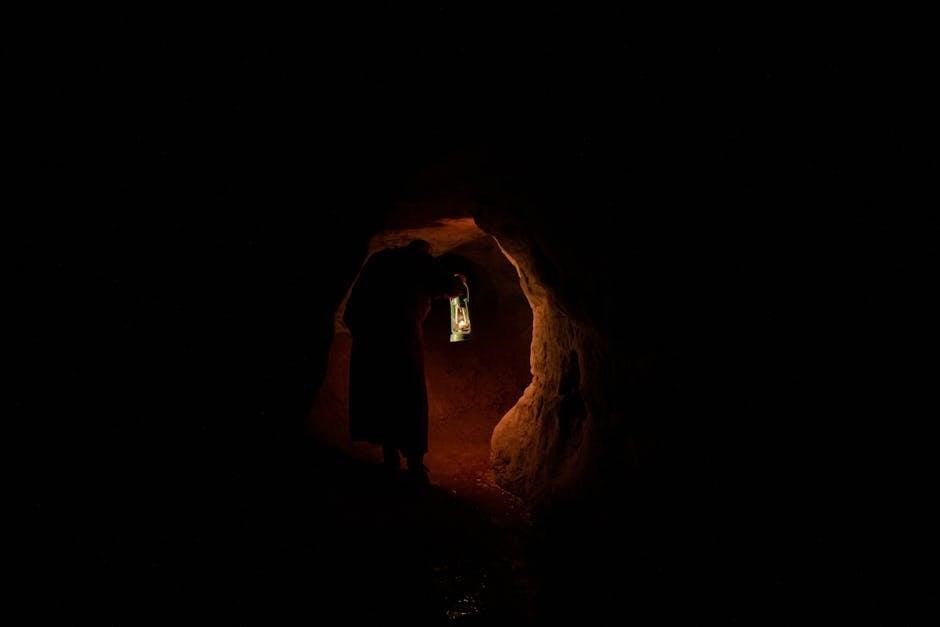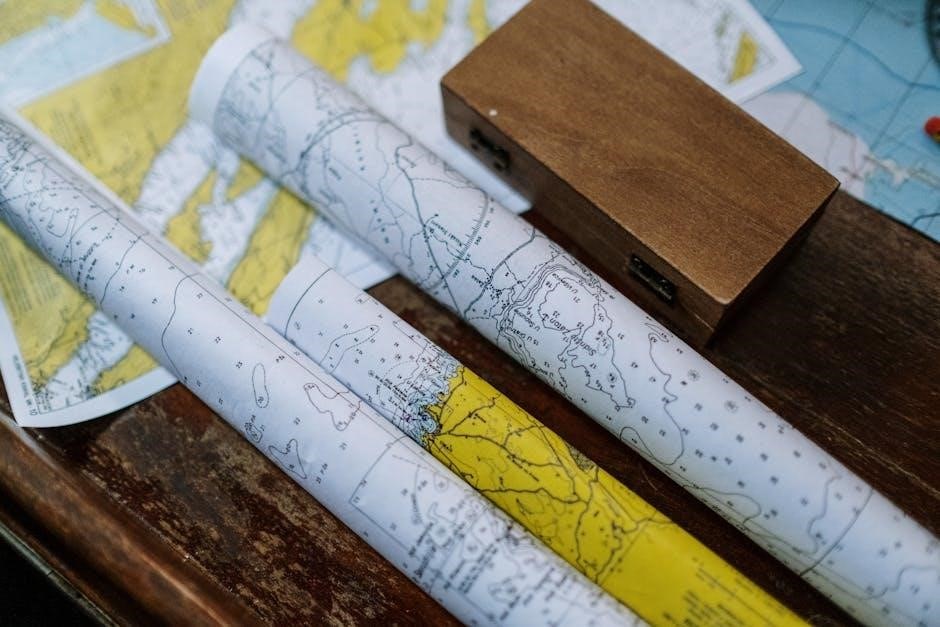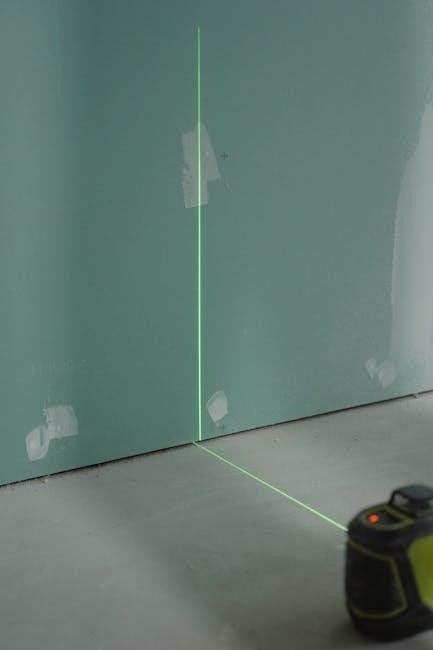Sod skinning is a landscaping technique involving the removal of the top layer of sod to prepare soil for new installations. It ensures a clean start.
1.1 What is Sod Skinning?
Sod skinning is a process where the top layer of sod‚ including grass and soil‚ is removed to prepare the ground for new landscaping. It involves using tools like sod cutters to strip the surface cleanly. This method is efficient for both small and large areas‚ ensuring a fresh start for new turf or seeding. It also helps improve drainage and soil quality.
1.2 Importance of Sod Skinning in Landscaping
Sod skinning is crucial for creating a clean slate in landscaping projects. It removes old‚ worn-out grass and soil‚ allowing for better drainage‚ nutrient distribution‚ and root growth. This process ensures proper preparation for new sod‚ seeds‚ or plants‚ promoting healthy and even growth. It also helps eliminate weeds and pests‚ enhancing the overall aesthetic and functionality of outdoor spaces.

Tools and Equipment Needed for Sod Skinning
The sod skinning process requires specific tools for efficiency and safety. Essential items include manual and mechanical tools‚ while safety gear ensures protection during the task.
2.1 Essential Tools: Sod Cutter‚ Shovel‚ and Rake
The sod cutter is the primary tool for slicing sod into strips‚ while the shovel aids in lifting and removing the cut sections. The rake evens the soil surface‚ ensuring a smooth base for new sod or seeding. Proper use of these tools ensures efficient sod removal and preparation. Essential for achieving professional results.
2.2 Optional Equipment: Wheelbarrow‚ Gloves‚ and Safety Goggles
A wheelbarrow helps transport sod efficiently‚ while gloves protect hands from blisters and cuts. Safety goggles prevent eye injuries from debris. These optional tools enhance comfort and safety‚ making the sod skinning process more manageable and efficient. They are highly recommended for a smoother experience‚ especially for larger or more demanding projects.

Preparing the Site for Sod Skinning
Preparing the site involves assessing the area‚ clearing debris‚ and marking the work zone. Tilling may be necessary to loosen the soil‚ ensuring a clean surface for new sod or seeding.
3.1 Assessing the Area for Sod Removal
Assessing the area involves evaluating the sod’s thickness‚ damage‚ and overall condition. Check for underground hazards like pipes or cables. Measure the area to determine the extent of sod removal needed. This step ensures a safe and efficient process‚ preventing unexpected issues during sod skinning. Proper assessment is crucial for successful soil preparation.
3.2 Clearing Debris and Marking the Work Area
Before sod skinning‚ clear the area of debris‚ rocks‚ and vegetation. Use a rake or shovel to remove loose materials. Mark the perimeter with stakes and twine to define the work zone. This step ensures a clean start‚ prevents damage to surrounding areas‚ and helps maintain focus during the sod removal process. Proper preparation is essential.
3.3 Tilling the Soil (If Necessary)
After clearing debris‚ till the soil if it’s compacted or uneven. Use a garden tiller to break up the soil‚ ensuring proper drainage and aeration. This step promotes healthy root growth for new sod or seeding. Tilling also helps level the ground‚ creating a smooth surface for installation. It’s essential for achieving optimal results in landscaping projects.
Safety Precautions
Ensure proper tool handling and be aware of underground cables and pipes to avoid accidents. Always maintain a clear‚ stable work area to prevent trips or falls.
4.1 Protective Gear: Gloves‚ Safety Goggles‚ and Steel-Toe Boots
Wearing gloves protects hands from cuts and blisters‚ while safety goggles shield eyes from debris. Steel-toe boots prevent foot injuries from heavy tools or dropped objects. Proper gear ensures safety and comfort during sod skinning tasks‚ making it essential to wear them consistently throughout the process. Always choose durable‚ high-quality protective equipment for optimal protection.
4.2 Avoiding Hazards: Underground Cables and Pipes
Before sod skinning‚ locate underground cables and pipes to prevent damage or accidents. Use a cable detector or consult utility maps. Marking these areas ensures safe tool operation. Cutting through underground lines can cause severe injuries or costly repairs. Always verify the location of utilities to avoid potential hazards during the sod removal process. Safety should never be compromised.
The Sod Skinning Process
The sod skinning process involves cutting‚ removing‚ and leveling the sod efficiently. Proper techniques ensure minimal soil damage and prepare the ground for new installations.
5.1 Cutting the Sod into Manageable Strips
Cutting sod into manageable strips is the first step in the sod skinning process. Use a sod cutter to slice the sod into uniform strips‚ typically 12–18 inches wide. This method ensures easy removal and minimizes waste. Make shallow cuts to avoid damaging the underlying soil. Properly aligned strips facilitate smoother removal and preparation for new landscaping projects.
5.2 Removing the Sod Layers
After cutting the sod into strips‚ use a shovel or sod cutter to carefully pry and lift the layers. Work in small sections‚ gripping the sod firmly and pulling upward to avoid tearing. Remove each strip completely‚ piling them neatly for disposal. Ensure the underlying soil is exposed and free of residual sod fragments for a smooth surface. This step is crucial for successful sod skinning.
5.3 Smoothing and Leveling the Ground
After removing the sod‚ use a rake or shovel to smooth the soil‚ ensuring an even surface. Fill any low spots with soil and compact it gently. Remove debris and rocks to create a uniform base. This step is essential for proper drainage and preparing the ground for new sod or seeding‚ ensuring optimal results.
Aftercare and Disposal
Proper disposal of sod is crucial. Compost usable material or dispose of it through local waste services. Prepare the soil for new sod or seeding;
6.1 Proper Disposal of Removed Sod
Proper disposal of removed sod is essential to maintain environmental balance. Composting sod is eco-friendly‚ as it enriches soil when reused. Alternatively‚ check local waste regulations for disposal options. Some communities offer special collection for yard waste. Avoid illegal dumping‚ as it harms ecosystems. Always follow local guidelines to ensure responsible disposal. Proper disposal protects the environment.
6.2 Preparing the Soil for New Sod or Seeding
After removing sod‚ the soil must be prepared for new installation. Till the ground to loosen compacted layers and improve drainage. Level the surface to ensure evenness. Apply organic matter like compost to enrich soil fertility. Rake the area smooth‚ removing debris. Proper preparation ensures healthy growth for new sod or seed‚ promoting a lush‚ uniform lawn. This step is critical for success.

Tips for Effective Sod Skinning
Efficient sod skinning requires careful planning and execution. Work in small sections for precision‚ maintain consistent soil moisture‚ and use the right tools to avoid damage.
7.1 Working in Small Sections for Precision
Working in small sections ensures accuracy and control during sod skinning. This method allows for precise removal of sod layers‚ minimizing damage to surrounding areas. By focusing on manageable strips‚ you can achieve a uniform result‚ making the process more efficient and reducing the risk of uneven ground or incomplete removal. This approach is particularly beneficial for maintaining landscape integrity.
7.2 Maintaining the Right Soil Moisture
Proper soil moisture is crucial for effective sod skinning. Slightly damp soil is easier to cut and remove‚ reducing effort and preventing soil cracking. Avoid working on overly wet or dry ground‚ as it can hinder the process or damage the soil structure. Maintaining optimal moisture ensures smoother sod removal and better soil preparation for subsequent landscaping projects.

Cost Estimation
Cost estimation for sod skinning involves calculating tools‚ labor‚ and disposal fees. Prices vary based on project size and location‚ ensuring accurate budget planning.
8.1 Calculating Tools and Equipment Costs
Calculating tools and equipment costs involves listing essential items like sod cutters‚ shovels‚ and rakes. Optional equipment such as wheelbarrows and gloves can add to expenses. Prices vary by brand and quality‚ so comparing options ensures budget-friendly choices. Rentals may also be a cost-effective alternative for one-time projects. Always consider longevity and maintenance costs when purchasing.
8.2 Labor Costs for Professional Sod Skinning
Labor costs for professional sod skinning vary based on the size of the area‚ complexity‚ and location. Rates typically range from $1 to $3 per square foot. Larger projects may offer discounts‚ while smaller‚ intricate jobs could cost more. It’s essential to request quotes from multiple contractors to compare pricing and services. Always clarify what’s included in the labor cost.
8.3 Disposal Fees and Other Expenses
Disposal fees for sod skinning can range from $30 to $100‚ depending on location and landfill regulations. Additional costs may include dumpster rentals or special permits. Some municipalities offer composting options‚ reducing fees. Always factor in transportation expenses if hauling sod yourself. Plan accordingly to avoid unexpected charges and ensure compliance with local waste management guidelines.

Environmental Considerations
Sod skinning involves eco-friendly practices like composting removed sod to reduce landfill use. Proper disposal ensures minimal environmental impact‚ promoting sustainable landscaping and soil health.
9.1 Eco-Friendly Disposal of Sod
Eco-friendly sod disposal involves composting or repurposing removed sod to minimize landfill waste. Composting sod creates nutrient-rich soil amendments‚ benefitting gardens and landscapes. Donate usable sod to local gardens or farms‚ or recycle it through municipal programs. Always check local regulations for proper disposal methods to ensure sustainability and reduce environmental impact. This approach promotes eco-conscious landscaping practices.
9.2 Impact on Soil Health and Ecosystem
Sod skinning can disrupt soil health by removing organic matter and exposing bare soil. This may lead to increased erosion and nutrient depletion. Ecosystems can be affected as microorganisms and small organisms lose their habitat. Proper aftercare‚ like reseeding or applying compost‚ helps restore soil health and supports local biodiversity‚ ensuring a balanced ecosystem.
Sod Skinning for Large Areas
Managing large-scale sod skinning requires efficient tools and strategies to cover extensive spaces effectively‚ ensuring uniform removal and preparation for new landscaping projects or seeding.
10.1 Hiring Professional Services
For large areas‚ hiring professional sod skinning services is often the most efficient option. Experts bring specialized tools and knowledge‚ ensuring quick and precise sod removal. They handle heavy labor‚ saving time and effort. Additionally‚ professionals can offer cost-effective solutions by minimizing waste and optimizing soil preparation. Always research reviews and compare services to find the best fit for your project needs.
10.2 Time Management for DIY Projects
Effective time management is crucial for DIY sod skinning. Break the task into smaller sections to maintain focus and avoid burnout. Allocate specific time slots for each step‚ from cutting sod to soil preparation. Plan according to your schedule‚ ensuring consistent progress. Proper organization and pacing will lead to a successful project without overwhelming yourself. Stay disciplined to achieve the best results.

Common Mistakes to Avoid
Common mistakes in sod skinning include cutting sod too thick or thin‚ not preparing soil properly‚ and ignoring safety precautions. Avoid these for best results.
11.1 Cutting Sod Too Thick or Too Thin
Cutting sod too thick leaves excess material‚ while too thin can damage the grass. Both affect removal efficiency and soil preparation. Proper blade adjustment ensures uniform cuts‚ maintaining sod integrity for easier handling and disposal. Avoid uneven layers to prevent future landscaping issues. Consistent slicing is key for a successful sod skinning process.
11.2 Not Preparing the Soil Properly
Failure to prepare soil before sod removal leads to uneven ground and poor drainage. Debris and rocks obstruct sod cutting‚ while improper tilling leaves compacted soil. This results in difficult sod removal and hinders new growth. Ensure soil is clear‚ loosened‚ and leveled for optimal results and easier sod skinning. Proper preparation prevents future landscaping challenges and ensures success.

Troubleshooting
Troubleshooting sod skinning involves addressing uneven ground and managing weeds or pests post-removal. Use leveling tools and preventive measures to ensure a smooth‚ healthy soil surface. Proper techniques prevent future issues and ensure successful sod skinning outcomes for landscaping projects. Be proactive in identifying and solving these common challenges effectively.
12.1 Dealing with Uneven Ground
Uneven ground can hinder sod skinning progress. Use a rake or shovel to level the soil after sod removal. Check for low or high spots and fill or remove soil as needed. A level surface ensures proper drainage and prevents future lawn issues. Regularly inspect and adjust the ground to achieve a smooth‚ even base for new sod or seeding.
12.2 Managing Weeds and Pests After Sod Removal
After sod removal‚ weeds and pests can quickly invade the exposed soil. Regularly monitor the area and remove weeds manually or with herbicides. Apply soil treatments to prevent pest infestations. Properly preparing the soil for new sod or seeding helps minimize future weed and pest issues‚ ensuring a healthy lawn or landscape.

Seasonal Timing
The best seasons for sod skinning are spring and fall‚ as moderate temperatures and moisture levels facilitate easier removal and soil preparation for new installations.
13.1 Best Seasons for Sod Skinning
The ideal seasons for sod skinning are spring and fall. Spring offers favorable temperatures and soil moisture‚ making sod easier to cut and remove. Fall provides cooler weather‚ reducing soil compaction and promoting healthy regrowth. Both seasons ensure optimal conditions for sod removal and soil preparation‚ leading to successful landscaping projects.
13.2 Avoiding Sod Skinning in Extreme Weather
Sod skinning should be avoided in extreme weather conditions like intense heat‚ heavy rain‚ or freezing temperatures. Extreme heat can dry out the soil‚ making sod removal difficult‚ while heavy rain may lead to muddy conditions and soil erosion. Cold weather hardens the ground‚ making sod cutting challenging. It’s best to wait for moderate weather to ensure effective sod skinning and maintain soil health.

Local Regulations
Local regulations may require permits for sod skinning‚ especially if it’s part of a larger landscaping project. Always check municipal guidelines to avoid legal issues.
14.1 Permits Required for Sod Skinning
Permits for sod skinning may be necessary‚ especially for large-scale projects or if sod removal affects drainage or neighboring properties. Check local ordinances to determine if a permit is required. Failure to obtain necessary permits can result in fines or project delays‚ so ensure compliance with all regulations before starting.
14.2 Disposal Regulations in Your Area
Disposal regulations vary by location. Check local guidelines for sod disposal‚ as some areas restrict landfilling organic materials. Many regions offer composting options or require separation of sod for proper recycling. Ensure compliance with environmental regulations to avoid penalties and promote eco-friendly practices. Proper disposal is crucial for sustainability.
Sod skinning is a valuable landscaping technique. Proper tools and techniques ensure success. Follow safety guidelines and environmental regulations for optimal results and a polished finish.
15.1 Summary of Key Points
Sod skinning is a landscaping technique involving sod removal for new installations. Proper tools like sod cutters and safety gear are essential. Site preparation‚ including debris clearing and tilling‚ ensures smooth outcomes. Post-removal‚ dispose of sod responsibly and prepare soil for new growth. Environmental considerations and local regulations must be followed for sustainable results. Effective planning and execution yield successful projects.
15.2 Final Tips for Successful Sod Skinning
To achieve optimal results‚ maintain consistent soil moisture‚ work in small sections‚ and use sharp tools for clean cuts. Monitor progress to avoid unevenness and adjust techniques as needed. Proper disposal and soil preparation are crucial for new growth. Stay organized‚ follow safety guidelines‚ and consider professional help for large areas to ensure a successful sod skinning project.